3. assembly of the vibrator
3.1 Piston vibrators with linear vibration
These vibrators are mainly used as conveying aids or drives. The most commonly used conveying solutions are pipe, trough and spiral conveyors. Piston vibrators are not recommended for emptying bunkers.
3.1.1 Conveyor troughs
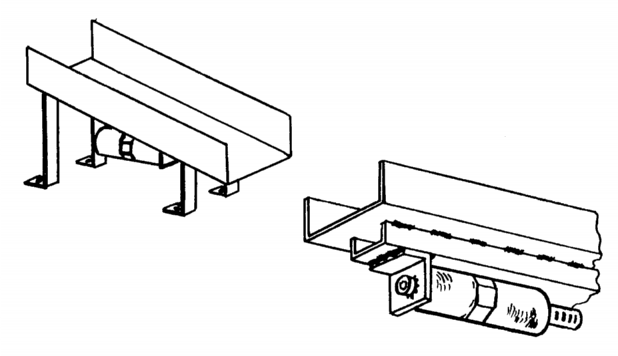
Chutes
Material conveying via chutes and troughs is usually based in the support of gravitational force, as they are often designed with a downward slope. To ensure the function of the vibrator, the chute should be supported on metal, fiberglass or rubber springs. The direction of vibration is preferably horizontal or slightly inclined.
Make sure that the vibrator can be connected to the trough in a vibration-resistant manner. If this is not the case with the existing construction, a vibration-resistant profile should be installed along the full length of the trough on which the vibrator is mounted.
3.1.2. pipe conveyor
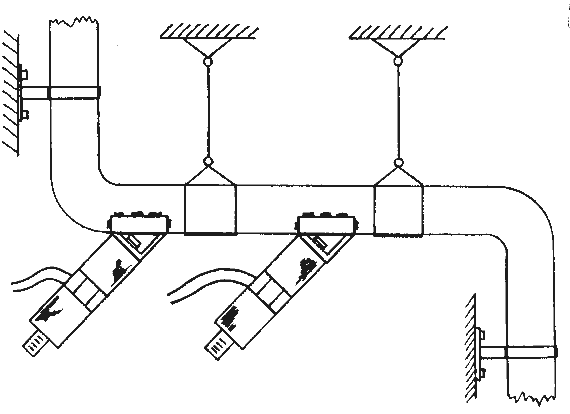
Pipe conveyor
Channel or tube conveyors as shown above are used, among other things, to convey fine materials such as powder, flour, sugar, etc. between silos and the processing production equipment. The advantage is that the material only comes into contact with the conveying tube, which protects against contamination and can be made of chemically resistant material or stainless steel. In this way, the material and the environment can be protected according to the guidelines of the chemical, pharmaceutical and food industries.
The vibrators should be placed at an angle of 45° to convey the material forward. If necessary, ribs in an upward inclined pipe can also ensure conveying.
It is important that the pipe is rigid, but not rigidly mounted. In the case of long pipes, it is possible to mount several piston vibrators, but they should be of the same type, so that, assuming rigid construction, the vibrators can synchronize in frequency and phase. The tube can be additionally stiffened by a strong profile welded from the outside. Please note that the profile ends are not welded on at the first 3mm.
3.1.3. helical conveyor
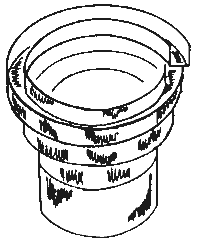
Bowl feeder
Bowl feeders are used, among other things, to automatically convey small parts into machines.
As a rule, bowl feeders are driven electrically or electromagnetically. Pneumatic piston vibrators are advantageous when space is limited and high vibration energy is required.
Spiral conveyors should be placed on spiral springs or rubber elements. An imaginary vertical pivot is achieved by mounting two piston vibrators in opposite directions. The exact mounting angle must be tested in practice, but an angle of 45° to the conveyor floor is usually a good choice.
3.2 Vibrators with radial vibration
These vibrators produce sinusoidal vibration and are superior to piston vibrators, especially in resonance generation of the material. The vibration frequency can be adjusted over a wide range by using a pressure or flow controller.
Circular vibrators are often used to compact or separate material. A common application is emptying silos, bunkers and hoppers by shaking off adhering material and conveying it downward by gravity.
Another application is the conveying of material when piston vibrators are not sufficient for the vibration requirements due to their limited working torques, such as in gravel conveying. The sinusoidal excitation of circular vibrators can also be advantageous for screening material.
Linear vibrators are less recommended for compacting concrete, since they compact the concrete during forward motion and unload it again in return. Therefore, two types of vibrators are mainly used for concrete compaction:
Electrically, pneumatically or mechanically driven needle vibrators are embedded in the concrete and compact it from the inside by their rotating mass. The advantage of these needle vibrators is their use in large concrete structures such as buildings or bridges where compaction from the outside is not practical due to the thickness of the concrete.
External vibrators such as roller or turbine vibrators are therefore mainly used in the construction of thin walls, pylons or in tunnel construction. By attaching them to formwork, the concrete is compacted particularly strongly at the surface, which also results in better waterproofing of the concrete surface.
3.2.1 Mounting on hoppers and bunkers
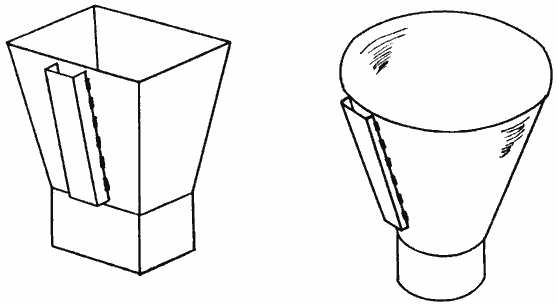
Use of a U-profile
The use of a U-profile which is not continuously welded to the hopper vertically is the best method to bring the vibration energy to the material in the hopper. For square bunkers, the profile should be centered on the wider side. Note that the frame construction should not be closer than half the length of the profile, otherwise the frame will absorb most of the vibration energy and may be damaged.
The profile acts as a stiffener so that the vibration energy is transmitted along the full length of the profile. However, the vibration force remains greatest near the vibrator, so it makes sense to position the vibrator on the profile so that it is placed in a 90° line to the center of bridging or adhesion of the material (see figure below). If this point is not known, experience shows that placing the vibrator at 1/3 of the height of the hopper or hopper is usually ideal.
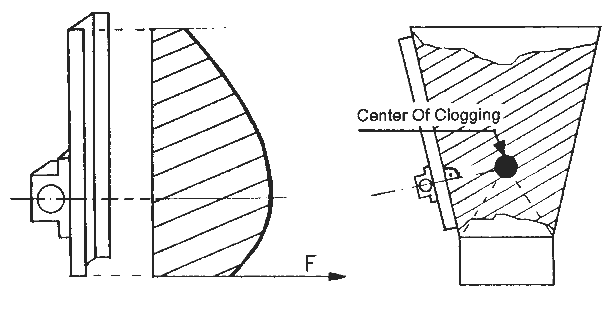
Vibration energy distribution from the profileCenter of bridging
Instead of a U-profile, a plate can also be welded to the wall as a stiffener to bring the vibrations into the hopper. However, due to the plate thickness, area and weight, some of the vibration energy is lost to vibrate the plate itself.
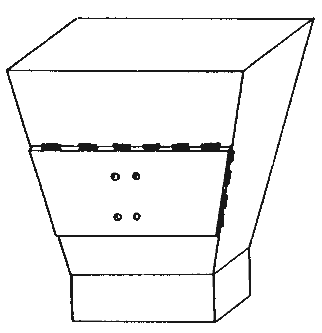
Use of a stiffening plate
3.2.2 Mounting on sieves
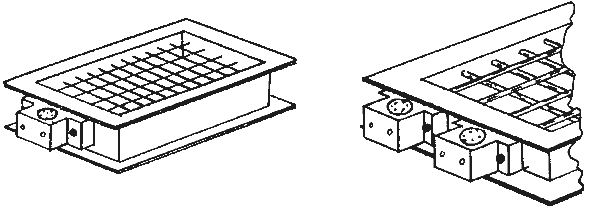
Mounting on sieves
As mentioned above, screens behave similarly to gutters. They should be driven by one or more vibrators mounted on the narrower side or in the center. With heavy material such as gravel, one vibrator is often not powerful enough. In this case, two vibrators can be mounted which should be positioned as close to each other as possible. The two vibrators will immediately synchronize and deliver twice the vibration force. Please make sure that the frame is stiff enough to support the vibration force. If this is not the case, the strength of the frame can be increased by attaching two U or H profiles as shown in the following picture. In this case, the vibrator should be placed in the center of the profiles.
The screen should be mounted on springs or rubber elements so that the vibration energy is not absorbed by the structure. Make sure that the compressed air connections and hoses cannot be mechanically damaged. When using the vibrator in outdoor areas, please also refer to paragraph 6.1.4.
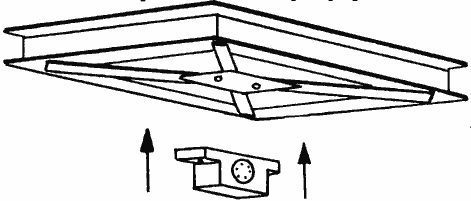
Reinforcement of the sieve bottom
3.2.3. mounting on a concrete mold
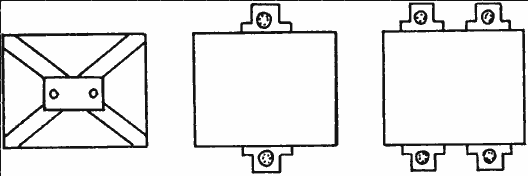
Mounting on a concrete form (bottom view)
As with bunkers, it is recommended to mount U-profiles or plates to allow the vibration energy to act in a distributed manner on the concrete mold. If the mold is very small (< 50×50cm), the vibrator can be mounted in the center under the mold. For larger molds, it is recommended to place two or four opposite vibrators on the longer side of the mold.
As usual, the vibrators will synchronize after start-up, provided that the construction is sufficiently rigid, and the concrete mold should be supported on springs or rubber elements in such a way that it does not vibrate when the vibrators are switched off.
3.2.3 Mounting on concrete formwork
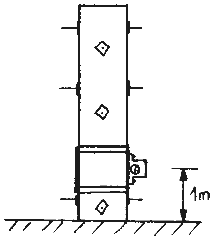
Mounting on a formwork
If the cross section is not too large, under normal circumstances wooden or metal formwork is stiff enough to mount a vibrator. A good mounting location is at the bottom of the formwork at about 1m height. This provides optimum vibration of the lower part of the formwork, as the upper part is relatively free to move and the reinforcement transmits the vibrations upwards. For formwork, as shown above, up to a height of 4m, one vibrator is usually sufficient.
For higher formwork, instead of using 2 or more vibrators, the lower area should be compacted first and then compacted further upwards at intervals of a few meters.
The vibration time depends individually on the concrete and its ingredients.
In contrast, formwork for walls is usually not very stiff and the vibration energy is not sufficiently transmitted over the formwork surface with one vibrator. In this case, several smaller vibrators placed side by side can do the compaction work. Here, too, the wall should be compacted upwards piece by piece (at intervals of 1 to 2m maximum).
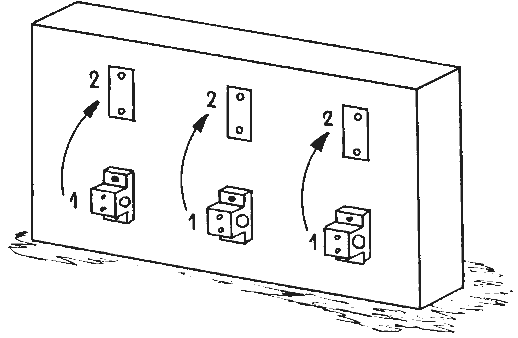
 Deutsch
Deutsch English
English Nederlands
Nederlands

![[Translate to Englisch:]](/fileadmin/user_upload/Neue_Bilder_2022/Headerbilder/Header.jpg)